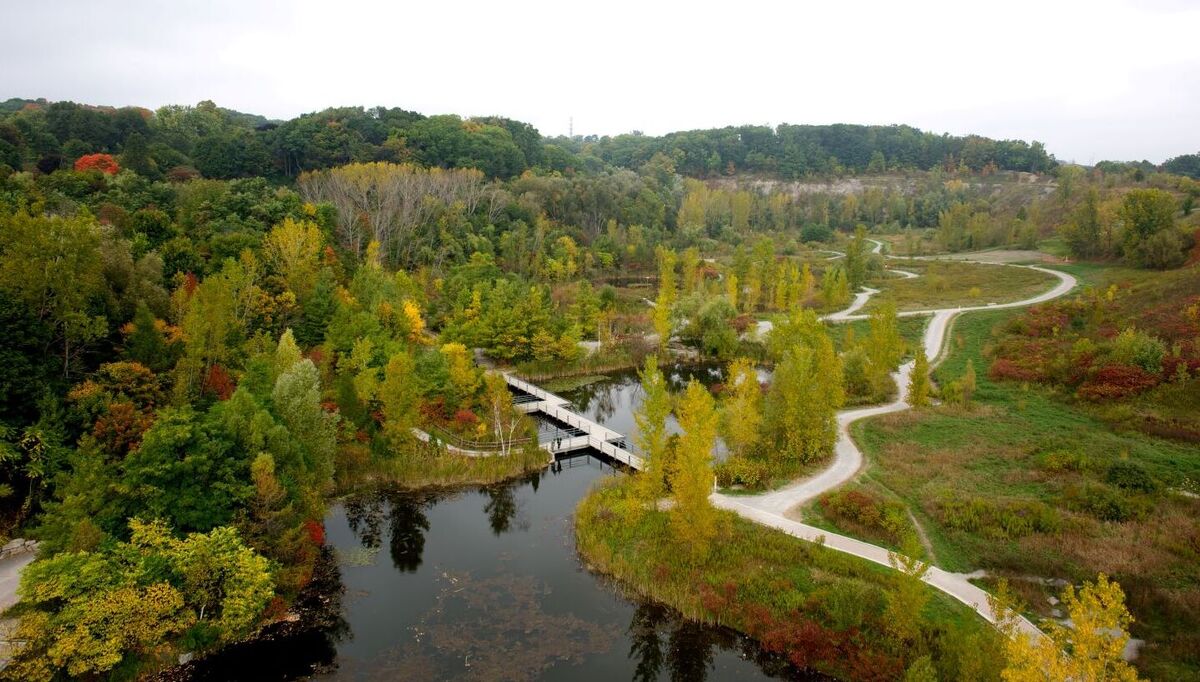This year marked a major milestone in Ontario—the official 20th anniversary of the Greenbelt.
For two decades, the Greenbelt has protected precious farmland, forests and wetlands, ensuring a sustainable future for generations to come.
But did you know Evergreen Brick Works is part of the Greenbelt? Toronto’s ravines, also known as urban river valleys, were added to the Greenbelt back in 2017. Being situated in the Don River ravine system, a protected part of the Greenbelt, means we’re lucky to be part of this incredible network.
Running through southern Ontario and into Lake Ontario are 21 of these urban river valleys. These systems do more than shape the landscape—they protect surrounding communities from flooding, filter water before it reaches Lake Ontario and help cool urban areas during heat events. At the same time, they support biodiversity, provide corridors for species migration and offer growing opportunities for outdoor recreation.
In adding those areas to the Greenbelt, the goal was to reflect their very real importance, says Edward McDonnell, CEO of the Greenbelt Foundation.
“These urban river valley systems, going through highly urbanized areas, are critically important from a biodiversity and connectivity perspective,” he says. “Whether you’re talking about managing stormwater, water quality, they play a unique and irreplaceable function.”
Ontario’s Greenbelt now includes over 800,000 hectares of protected land, and extends 325 km from the eastern end of the Oak Ridges Moraine, near Rice Lake, in the east, to the Niagara River in the west. These great systems don’t necessarily follow human geography or municipal boundaries, so the addition of urban river valleys allows the Greenbelt Foundation to think on a regional basis for how these ravines work in concert with the larger surrounding area.
McDonnell points out that they couldn’t do this work without partnerships with local communities and organizations—and says individuals can help protect these incredible areas as well.
“People can definitely get involved in local efforts to care for the ravines. They can join, or contribute to, stewardship organizations that are already involved, like Toronto and Region Conservation Authority or Don’t Mess with the Don, or just think of their own respectful use of these areas.”

YouTube: Celebrating 20 Years of Ontario’s Greenbelt!
McDonnell, a Toronto resident, says he too benefits from being close to ravines and other natural areas that are part of the Greenbelt. Now, as he looks back at the past 20-year history of the Greenbelt, he says it’s so interesting to see the journey from an ambitious idea to a tangible reality.
“It’s hard to imagine, because, in the context of Canada, it’s a very small area. But the Ontario Greenbelt is arguably the most successful Greenbelt in the world. The impact is incredibly important to this part of Ontario, where one in four Canadians live.”
Looking ahead, the Greenbelt will continue to play a critical role as Ontario’s population grows.
“We’re growing as a province, which means we need more of what the Greenbelt provides, not less,” he says. “It’s where we get fresh air, amazing food andnatural spaces. We’re looking forward to the next 20 years and continuing to protect, enhance and invest in the Greenbelt. That way it will be there for the needs of the future and for our children.”
Learn more
Interested in more of our work around the ravines? Subscribe to the newsletter in 2026 where we’ll share more plans for an 80km loop of trails through the ravines and along the waterfront!





